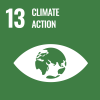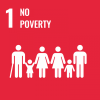Photo: IOM/Mashrif Abdullah Al
Last November, Bangladesh marked 50 years since the 1970 Great Bhola Cyclone – arguably the deadliest tropical cyclone in history. Compounded by a lack of preparedness and evacuation measures, the huge storm killed up to half a million people.
Bangladesh's proximity to the Bay of Bengal exposes the country to frequent tropical cyclones along its 580 kilometres of coastline, especially in Cox’s Bazar District, which hosts almost 900,000 Rohingya refugees from Myanmar. The cyclones often inflict heavy casualties, as well as floods, landslides, and extensive damage to facilities.
The more recent Cyclone Bulbul, which pounded Bangladesh in November 2019, became one of the longest and harshest cyclones the country had seen in decades. Although the country was better prepared then to respond and limit the loss of life, casualties were still recorded.
Last year’s Cyclone Amphan was just as strong, causing widespread damage and disruption for 2.6 million people across the predominantly low-lying country.
In 2020 alone, more than 4.4 million people in Bangladesh were displaced by storms and floods, many of whom were pre-emptively evacuated and have been unable to return home.
Due to its proximity to the Bay of Bengal, Cox’s Bazar is prone to frequent tropical cyclones. Photo: IOM/Mashrif Abdullah Al
Since the Great Bhola Cyclone, significant strides have been made in improving early warning systems and Disaster Risk Reduction (DRR) measures. However, according to the Government’s District Administration, nearly a third of the 1 million people living in vulnerable hilly areas in Cox’s Bazar are still at risk of landslides.
The International Organization for Migration (IOM) is working closely with the Government of Bangladesh to strengthen the disaster management capacities of host communities and local authorities. Since 2019, IOM has renovated 23 cyclone shelters in Ukhiya and Teknaf upazilas (or sub-districts), which regularly face shocks linked to various natural hazards.
Likewise, due to their remoteness, many cannot access activities which could increase their preparedness and reinforce key infrastructure. By integrating DRR features, IOM hopes to strengthen their ability to mitigate, withstand and respond to shocks and disasters, and ultimately build their resilience.


The teams are finalizing the rehabilitation of 22 multi-purpose cyclone shelters for host communities. Photo: IOM/Mashrif Abdullah Al
IOM is now finalizing the rehabilitation of another 22 multi-purpose cyclone shelters for host communities. These structures will be upgraded to accommodate about 33,000 individuals if a cyclone hits. Improved water, sanitation and hygiene facilities, electricity, access for people with disabilities, and gender-friendly accommodation will be ensured throughout the rehabilitation process.
Separate washroom facilities have been built for women and lighting will be installed to enhance safety. Additionally, solar lights in front and on the edge of roofs will ensure visibility for nearby communities.
The cyclone shelters have been equipped with emergency equipment, such as stretchers, first aid kits, personal protection equipment, megaphones, metal boxes to preserve documents, and radios for weather updates. All community members engaged in the project have received First Aid training.
With the monsoon season in full swing, the Kutupalong High School-Cum-Cyclone-Shelter got a much-needed makeover. Photo: IOM/Mashrif Abdullah Al
Many schools throughout the country double as a safe space for students to learn and a place to take shelter in case of disasters. However, due to the ongoing COVID-19 pandemic, schools in Bangladesh have been closed for more than a full academic year and maintenance works have been neglected.
These designated spaces have been essential throughout the years for people looking to take refuge from cyclones. “This cyclone shelter is particularly important to the Kutupalong community. Many disadvantaged community members and Rohingya refugees took shelter here during the cyclones of 1994 and 1996,” says Muhammad Abdul Mannan, headmaster at the Kutupalong High School, one of the shelters being renovated.
Because of school closures, these spaces became run down and unfit to provide shelter. “The cyclone shelter located in the Kutupalong High School was neglected soon after its construction,” says Mannan. With Bangladesh’s cyclone season underway, it was essential for the maintenance and rehabilitation works to resume as soon as possible.
The schools being upgraded to cyclone shelters are also committing to strengthening their DRR and preparedness capacities. The activities will include disaster management planning, capacity building of school management committees, and simulation exercises on multi-hazard preparedness.


Cash-for-Work activities encourage community members to take ownership of the shelters while providing an income for their families. Photo: IOM/Mashrif Abdullah Al
The current pandemic has put an enormous socioeconomic strain on an already frail economy in Cox’s Bazar and many are struggling to make ends meet. The maintenance support for cyclone shelters is providing vulnerable host community members with an opportunity to earn a living, with activities ranging from regular maintenance to construction and repair works.
“During the monsoon season, I can’t find work in the local community, so the school authority gave me a job here,” says community member Premashi Sharma. “Thanks to this job, I can take care of my family, pay for my children’s tuition and buy school supplies.”
Over a two-year period, IOM will implement 138 initiatives in 72 locations, accompanied by short-term employment opportunities which will consider the needs, interests and vulnerabilities of each participant. By actively engaging them in the maintenance works, IOM aims to encourage community members to take ownership of the shelters.
Premashi’s daughter, a student at the Kutupalong High School, will also benefit from studying in clean and renovated classrooms once school resumes. “If the cyclone shelter here is clean, then students can carry on with their studies and people can stay in the shelter when they are in danger,” says Premashi.
The renovation of cyclone shelters and complementary Cash-for-Work activities for host communities in Cox’s Bazar are possible thanks to the support of USAID’s Bureau for Humanitarian Assistance (BHA).
This story was written by Monica Chiriac, IOM’s Public Information Officer in Cox’s Bazar, Tel: +880 1880 084 048, Email: mchiriac@iom.int.


